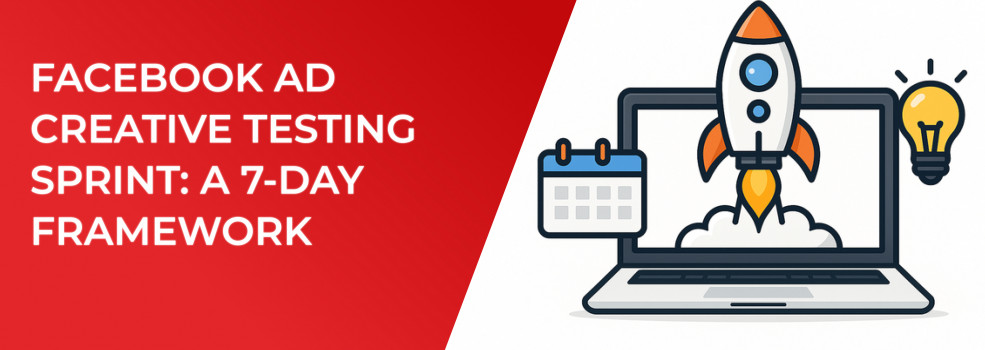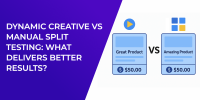Most marketers treat Facebook ad performance like a black box, tweaking bids and hoping the algorithm will smile on them. A controlled experiment beats guesswork every time. The Facebook Ad Creative Testing Sprint is a one-week plan that surfaces winning creatives quickly, cuts wasted spend, and establishes repeatable Facebook ad optimization loops, even if you manage only a modest budget.
Why a sprint beats endless tweaking
A sprint compresses learning into days instead of weeks, generates fresh ad impressions Facebook users actually notice, and gives stakeholders results in one calendar week, not “sometime next quarter.” The simple North Star is higher click-through rates, lower cost per click, and a healthier ROAS — numbers every finance team understands.
Day 1 – Benchmark and baseline your account
What you do
-
Pull the last 30 days of stats: spend, conversions, average click-through rate on Facebook ads, CPM, and CPC.
-
Compare those figures to public ROAS benchmarks and your historical targets.
-
Save the sheet — it becomes Friday’s control group.
Start with a clear snapshot of your current performance before any creative testing begins.
Why it matters
Without a baseline you cannot run meaningful ads analysis or prove uplift later. Even a depressing baseline is valuable because it sets the bar low for improvement. If you’re unsure which metrics deserve top priority, our detailed walkthrough on analyzing Facebook ad performance beyond CTR and CPC breaks it down step by step.
Day 2 – Audit creative and extract learnings
What you do
• Open Ads Manager → Columns → Performance and scan each ad for healthy or weak CTR.
• Flag any learning-limited Facebook ads; these are poor templates for future builds.
• Capture winning headlines, thumbnails, offers, and CTAs into a swipe file.
Why it matters
Patterns emerge quickly when you view creative side by side. That swipe file fuels tomorrow’s brainstorming and keeps you from repeating past mistakes. Spotting early signs of creative burnout? Read how to identify and fix Facebook ad fatigue before it eats your budget.
Day 3 – Ideate and mock up four fresh concepts
Creativity drives the sprint’s upside, so give this step uninterrupted focus. Set a 30-minute timer for rapid ideation.
Concept checklist
• A benefits-first image that shouts value in three words.
• A story-driven video featuring a customer sound bite.
• A curiosity-gap hook that begs a click (“This small tweak cut CPC by 47%”).
• A wildcard — meme, “ugly” ad, or selfie-cam testimonial.
Need inspiration for layouts and media types? Browse the ultimate guide to Facebook ad formats first. After brainstorming, turn each idea into a static image or 15-second Reel. Label assets clearly (Concept-A, Concept-B…). Remember Facebook advertising best practices: mobile-first framing, large text, clear single CTA. Decide which concept deserves budget even if only one survives; that clarity helps tomorrow.
Day 4 – Build the test campaign
Steps to execute
-
Create a new campaign, switch on Advantage Campaign Budget, and choose a daily limit that allows roughly 1,000 impressions per ad. Not sure which objective fits your test? See the pros and cons in our breakdown of Meta ad campaign objectives.
-
Use one ad set per concept with broad or 1% lookalike targeting.
-
Verify your pixel; if you run WordPress, follow a Facebook Pixel WordPress guide and test events. Proper pixel hygiene also speeds delivery; here’s how to finish the Facebook learning phase quickly once your test is live.
-
Attach UTMs so Google Analytics or Looker captures clean data.
Running four ad sets simultaneously lets the algorithm spot winners while avoiding data cannibalization. Aim to leave the learning phase within 24–36 hours.
Day 5 – Run a 24-hour pulse check
Pulse-check questions
• Are all creatives approved and delivering ad impressions Facebook users can see?
• Which ad already beats a 1% CTR?
• Is any concept spending more than twice your target CPA with no conversions? Pause it.
Look beyond conversions, early indicators like CTR and cost-per-thruplay tell you what’s resonating.
If Ads Manager shows the dreaded “Ad Set May Get Zero” warning, follow this checklist: why you see it and how to fix it. Conversions often lag impressions by a day or two, so focus on soft metrics like CTR and cost-per-thruplay right now. Record surprises and worries; they inform tomorrow’s edits.
Day 6 – Deep-dive and optimize
What you do
• Export yesterday’s spend and result columns to Sheets for quick ads analysis.
• Duplicate the top performer, then tweak a single element: headline, first three seconds, or CTA button color.
• If budget permits, group winners into one ad set and turn on campaign budget optimization for smoother scaling.
Minor creative edits preserve social proof and keep you inside the learning phase while squeezing extra conversions out of early traction. Small swings today prevent big resets tomorrow.
Day 7 – Scale and document everything
Final tasks
-
Increase budget on the top ad 20–30% per day or let CBO handle ramp-up. To push spend without tanking ROAS, follow the principles in the science of scaling Facebook ads without killing performance.
-
Shift the winner into evergreen campaigns so it can collect cheap conversions for weeks.
-
Write a brief memo titled “What worked, what bombed, next steps.” Future you (and your boss) will love the clarity.
Close with a team retrospective: What felt easy? What slowed us down? How can we move faster next cycle? Capture answers before memory fades.
Key takeaways
• Small, rapid tests beat big, slow launches.
• Creative quality outranks micro-targeting tweaks for long-term Facebook ad optimization.
• Treat every test, good or bad, as tuition; results compound over time. Effective optimization is not a one-time project, it’s a habit worth protecting.
Ready-to-print sprint checklist
⇒Baseline metrics recorded
⇒Four new creatives designed
⇒Pixel and UTMs verified
⇒Budget and schedule set
⇒24-hour pulse check complete
⇒Winners duplicated and scaled
⇒Post-mortem documented
Run this playbook once per quarter and you will stop asking what the average click-through rate on Facebook ads should be—because your account will set the benchmark others quote.

